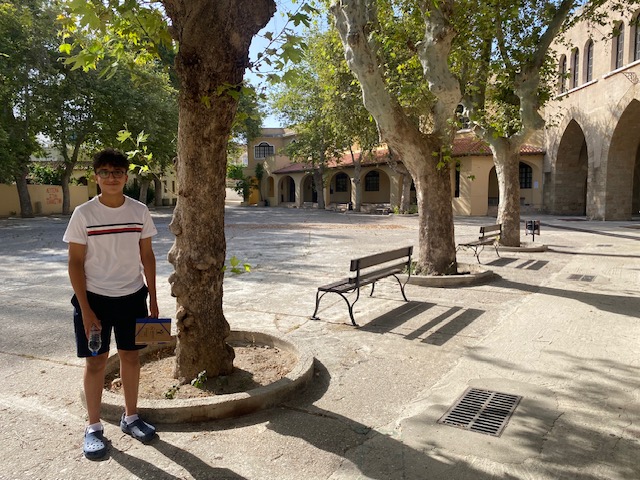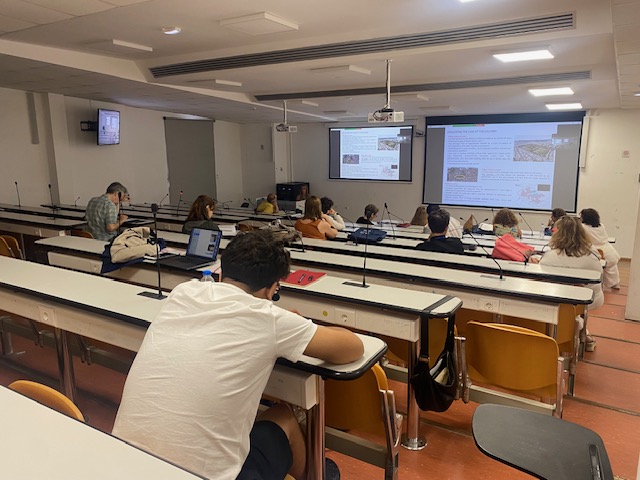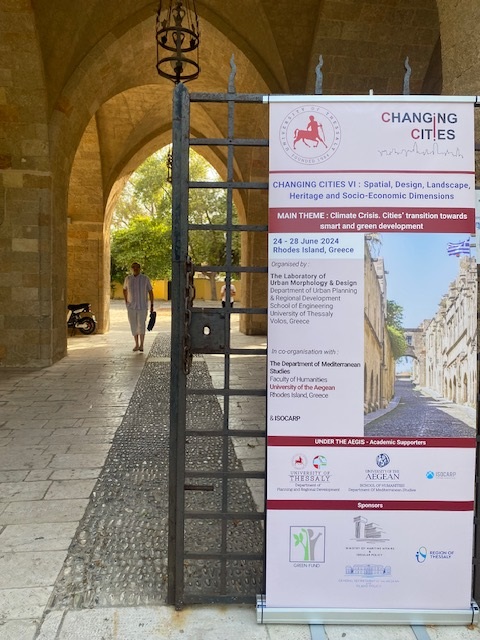Changing Cities - Mido Elseragy
My experience at the 6th international changing cities conference, Rhodes, Greece
Last month, I was lucky enough to attend the 6th international changing cities conference which took place in Rhodes, Greece. The conference was divided into themes and included around 300+ presented papers and research work delivered by professors and scholars from all over the world. The conference was delivered by hybrid delivery, which means papers and research work was presented and attended both online and in person. The idea of the conference being delivered in a hybrid delivery was first introduced during and after the pandemic, when travel and face to face meetings were prohibited. This idea has continued, allowing more researchers and scholars to attend, as they may not be able to attend face to face because of the high cost of travel or to personal inconveniences.
The Changing Cities Conference has a rich history that spans over four decades, with its roots dating back to the 1970s. The conference was first held in 1978 in Vancouver, Canada, and has since become a premier international event for urban planners, policymakers, and researchers to share knowledge and discuss the latest trends and innovations in urban development. The early years of the conference were marked by a focus on urbanization and the challenges that cities were facing in the post-war period. The first conference, held in Vancouver, addressed topics such as urban renewal, housing, and transportation. The conference was a success, attracting over 1000 participants from around the world.
In the 1980s, the conference shifted its focus to more specific topics such as urban design, planning, and management. The 1982 conference in Montreal, Canada, focused on the theme of "Urban Development: A Global Perspective," and featured keynote speakers from around the world. This was followed by conferences in Tokyo (1985) and Sydney (1988), which explored topics such as urban policy, urban ecology, and sustainable development.
The 1990s saw a significant increase in the global focus on sustainable development, and the Changing Cities Conference reflected this shift. The 1992 conference in Barcelona, Spain, had a strong emphasis on sustainable urban development, with keynote speakers discussing topics such as environmental sustainability, social equity, and economic viability. This was followed by conferences in Manchester (1994), Los Angeles (1996), and Brisbane (1998), which explored topics such as urban regeneration, urban governance, and community engagement.
In the 2000s, the conference continued to evolve to reflect changing global trends and priorities. The 2002 conference in Curitiba, Brazil, focused on sustainable transportation and urban planning, while the 2005 conference in Vienna, Austria, explored the theme of "Cities for All: Social Inclusion and Urban Development." The 2008 conference in Rotterdam, Netherlands, focused on climate change and its impact on cities. In recent years, the Changing Cities Conference has continued to address pressing global challenges such as urbanization, climate change, and social inequality. The 2012 conference in Bangkok, Thailand, focused on "Sustainable Urban Development: A New Era of Collaboration," while the 2015 conference in Lima, Peru, explored the theme of "Urban Resilience: Building Cities that Adapt to Climate Change." The 2018 conference in Montreal, Canada, focused on "Innovative Urban Governance: Creating Smarter Cities".
Throughout its history, the Changing Cities Conference has played an important role in shaping urban policy and practice around the world. It has brought together experts from diverse fields to share knowledge and expertise on key issues facing cities today. The conference has also provided a platform for policymakers to discuss common challenges and develop new solutions for urban development. In conclusion, the Changing Cities Conference has a rich history that reflects the evolving needs and priorities of cities around the world. From its early focus on urbanization and sustainability to its current emphasis on climate change and social inequality, the conference has played an important role in shaping urban policy and practice. As cities continue to face new challenges and opportunities in the decades ahead, the Changing Cities Conference will remain an important platform for discussion and innovation.
One of the sessions I particularly enjoyed:
Sicani Area: Data and Discussion
- The Sicani area, located in central-western Sicily, is an archaeologically significant region. It is named after the Sicani people, an ancient tribe considered one of the island's earliest inhabitants. This area offers a rich tapestry of historical, cultural, and environmental elements that provide insights into ancient Mediterranean civilizations.
- The Sicani mountains form a significant part of this region, characterized by rugged terrain and a mix of agricultural land and natural landscapes. The climate is typically Mediterranean, with hot, dry summers and mild, wet winters, conducive to a variety of agricultural practices.
- The data from the Sicani area highlight a dynamic interaction between indigenous cultures and external influences. This is evident in the mixed styles of pottery and metalwork, suggesting a degree of cultural assimilation and adaptation. The adoption of Greek artistic styles, for example, reflects both the Sicani's openness to external ideas and their integration into broader Mediterranean networks.
- The settlement patterns and material culture indicate a society well-adapted to its environment. The construction of settlements in defensible positions and the use of local materials for building and crafting demonstrate an intimate knowledge of and adaptation to the local landscape. The agricultural practices inferred from archaeological remains, such as terracing and irrigation, further reflect the inhabitants' ability to exploit and manage their environment sustainably.
- The archaeological data from the Sicani area provide a comprehensive picture of an ancient society that was both locally grounded and regionally interconnected. The blend of indigenous traditions with external influences, coupled with evidence of social stratification and environmental adaptation, offers valuable insights into the cultural and economic dynamics of ancient Sicily. Further research and excavation in this region promise to deepen our understanding of the Sicani and their role in the broader Mediterranean context.
Key Themes and Topics: The key themes and topics in the conference included:
1) Smart Cities
- Technology and Innovation: Discussions centred around the integration of advanced technologies, such as the Internet of Things (IoT), artificial intelligence (AI), and big data analytics, to create more efficient and responsive urban environments.
- Digital Infrastructure: Presentations highlighted the importance of robust digital infrastructure in supporting smart city initiatives, from intelligent transportation systems to smart grids and public services.
- Citizen Engagement: Emphasis was placed on involving citizens in the development and implementation of smart technologies to ensure they address real community needs and enhance quality of life.
2) Resilient Cities
- Climate Adaptation: Sessions focused on strategies for cities to adapt to climate change impacts, including sea-level rise, extreme weather events, and changing precipitation patterns.
- Disaster Preparedness: Discussions included the development of disaster risk reduction plans, resilient infrastructure, and the role of urban design in mitigating the effects of natural disasters.
- Sustainable Practices: Emphasis was on sustainable urban practices, such as green building, renewable energy integration, and sustainable transportation systems.
3) Just Cities
- Social Equity: Topics covered included the importance of creating inclusive urban spaces that cater to all demographics, ensuring equal access to resources, and reducing socio-economic disparities.
- Affordable Housing: Presentations addressed the growing challenge of housing affordability, exploring policy measures, innovative housing models, and financial mechanisms to ensure access to housing for all.
- Public Spaces: The role of public spaces in fostering community engagement, social interaction, and cultural expression was a significant focus, with discussions on how to design inclusive and accessible public areas.
Outcomes and Future Directions
The 6th Changing Cities Conference concluded with a set of actionable recommendations and a commitment to continued collaboration among participants. Key outcomes included:
- Collaborative Networks: Establishment of new partnerships and networks to foster ongoing dialogue and collaboration on urban challenges.
- Policy Recommendations: Development of policy briefs and recommendations to guide urban planning and development at local, national, and international levels.
- Research Agenda: Identification of key research areas and priorities to advance the understanding of urban dynamics and support evidence-based policy-making.
Conclusion
The 6th Changing Cities Conference in Rhodes successfully brought together a diverse group of professionals to address the pressing issues of urbanization in the modern era. By focusing on smart, resilient, and just communities, the conference provided a platform for innovative ideas, collaborative solutions, and a shared vision for the future of cities. It was an eye opener for me in the world of research into this topic, especially sustainability of cities and communities and cultural heritage. Rhodes, with its blend of historical and contemporary urban elements, served as an ideal host, inspiring participants to envision and create better urban futures.



 Queen Elizabeth's Grammar
School
Queen Elizabeth's Grammar
School